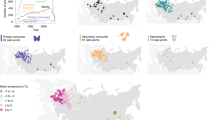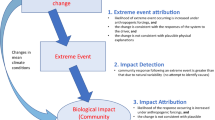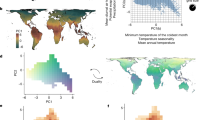Abstract
Causal attribution of recent biological trends to climate change is complicated because non-climatic influences dominate local, short-term biological changes. Any underlying signal from climate change is likely to be revealed by analyses that seek systematic trends across diverse species and geographic regions; however, debates within the Intergovernmental Panel on Climate Change (IPCC) reveal several definitions of a ‘systematic trend’. Here, we explore these differences, apply diverse analyses to more than 1,700 species, and show that recent biological trends match climate change predictions. Global meta-analyses documented significant range shifts averaging 6.1 km per decade towards the poles (or metres per decade upward), and significant mean advancement of spring events by 2.3 days per decade. We define a diagnostic fingerprint of temporal and spatial ‘sign-switching’ responses uniquely predicted by twentieth century climate trends. Among appropriate long-term/large-scale/multi-species data sets, this diagnostic fingerprint was found for 279 species. This suite of analyses generates ‘very high confidence’ (as laid down by the IPCC) that climate change is already affecting living systems.
This is a preview of subscription content, access via your institution
Access options
Subscribe to this journal
Receive 51 print issues and online access
$199.00 per year
only $3.90 per issue
Buy this article
- Purchase on Springer Link
- Instant access to full article PDF
Prices may be subject to local taxes which are calculated during checkout

Similar content being viewed by others
References
Intergovernmental Panel on Climate Change Third Assessment Report Climate Change 2001: Impacts, Adaptation, and Vulnerability (eds McCarthy, J. J., Canziani, O. F., Leary, N. A., Dokken, D. J. & White, K. S.) (Cambridge Univ. Press, Cambridge, 2001)
Easterling, D. R. et al. Climate extremes: observations, modeling, and impacts. Science 289, 2068–2074 (2000)
Parmesan, C., Root, T. L. & Willig, M. Impacts of extreme weather and climate on terrestrial biota. Bull. Am. Meteorol. Soc. 81, 443–450 (2000)
Pounds, J. A. Climate and amphibian declines. Nature 410, 639–640 (2001)
Otterson, G. et al. Ecological effects of the North Atlantic Oscillation. Oecologia 128, 1–14 (2001)
Walther, G.-R. et al. Ecological responses to recent climate change. Nature 416, 389–395 (2002)
Peñuelas, J. & Flella, I. Responses to a warming world. Science 294, 793–795 (2001)
Smith, R. C. et al. Marine ecosystem sensitivity to climate change. Biol. Sci. 49, 393–404 (1999)
Hoegh-Guldberg, O. Climate change, coral bleaching and the future of the world's coral reefs. Mar. Freshwater Res. 50, 839–866 (1999)
Lomborg, B. The Skeptical Environmentalist (Cambridge Univ. Press, Cambridge, 2001)
Moss, R. & Schneider, S. Cross Cutting Issues Guidance Papers Intergovernmental Panel on Climate Change (World Meteorological Organization, Geneva, 2000)
Thomas, C. D. et al. Ecological processes at expanding range margins. Nature 411, 577–581 (2001)
Rodriguez-Trellis, F. & Rodriguez, M. A. Rapid micro-evolution and loss of chromosomal diversity in Drosophila in response to climate warming. Evol. Ecol. 12, 829–838 (1998)
de Jong, P. W. & Brakefield, P. M. Climate and change in clines for melanism in the two-spot ladybird, Adalia bipunctata (Coleoptera: Coccinellidae). Proc. R. Soc. Lond. B 265, 39–43 (1998)
Gurevitch, J. & Hedges, L. V. Design and Analysis of Ecological Experiments 2nd edn (eds Scheiner, S. M. & Gurevitch, J.) 347–370 (Oxford Univ. Press, Oxford, 2001)
Thomas, C. D. & Lennon, J. J. Birds extend their ranges northwards. Nature 399, 213 (1999)
Parmesan, C. et al. Poleward shifts in geographical ranges of butterfly species associated with regional warming. Nature 399, 579–583 (1999)
Grabherr, G., Gottfried, M. & Pauli, H. Climate effects on mountain plants. Nature 369, 448 (1994)
Grabherr, G., Gottfried, M., Gruber, A. & Pauli, H. Arctic and Alpine Biodiversity (eds Chapin, F. S. III & Körner, C.) 167–181 (Springer, Berlin, 1995)
Ahas, R. Long-term phyto-, ornitho- and ichthyophenological time-series analyses in Estonia. Int. J. Biometeorol. 42, 119–123 (1999)
Bradley, N. L., Leopold, A. C., Ross, J. & Huffaker, W. Phenological changes reflect climate change in Wisconsin. Proc. Natl Acad. Sci. USA 96, 9701–9704 (1999)
Fitter, A. H. & Fitter, R. S. R. Rapid changes in flowering time in British plants. Science 296, 1689–1691 (2002)
Menzel, A., Estrella, N. & Fabian, P. Spatial and temporal variability of the phenological seasons in Germany from 1951 to 1996. Glob. Change Biol. 7, 657–666 (2001)
Menzel, A. & Fabian, P. Growing season extended in Europe. Nature 397, 659 (1999)
Menzel, A. Trends in phenological phases in Europe between 1951 and 1996. Intl J. Biometerol. 44, 76–81 (2000)
Roy, D. B. & Sparks, T. H. Phenology of British butterflies and climate change. Glob. Change Biol. 6, 407–416 (2000)
Beebee, T. J. C. Amphibian breeding and climate. Nature 374, 219–220 (1995)
Gibbs, J. P. & Breisch, A. R. Climate warming and calling phenology of frogs near Ithaca, New York, 1900–1999. Conserv. Biol. 15, 1175–1178 (2001)
Warren, M. S. et al. Rapid responses of British butterflies to opposing forces of climate and habitat change. Nature 414, 65–69 (2001)
Crick, H. Q. P., Dudley, C., Glue, D. E. & Thomson, D. L. UK birds are laying eggs earlier. Nature 388, 526 (1997)
Crick, H. Q. P. & Sparks, T. H. Climate related to egg-laying trends. Nature 399, 423–424 (1999)
Dunn, P. O. & Winkler, D. W. Climate change has affected the breeding date of tree swallows throughout North America. Proc. R. Soc. Lond. B 266, 2487–2490 (1999)
Gatter, W. Zugzeiten und Zugmuster im Herbst: Einfluss des Treibhauseffekts auf den Vogelzug? J. Ornithol. 133, 427–436 (1992)
Sagarin, R., Barry, J. P., Gilman, S. E. & Baxter, C. H. Climate-related change in an intertidal community over short and long time scales. Ecol. Monogr. 69, 465–490 (1999)
Beaugrand, G., Reid, P. C., Ibañez, F., Lindley, J. A. & Edwards, M. Reorganization of North Atlantic marine copepod biodiversity and climate. Science 296, 1692–1694 (2002)
van Hark, C. M., Aptroot, A. & van Dobben, H. F. Long-term monitoring in the Netherlands suggests that lichens respond to global warming. Lichenologist 34, 141–154 (2002)
Hersteinsson, P. & MacDonald, D. W. Interspecific competition and the geographical distribution of Red and Arctic foxes Vulpes vulpes and Alopex lagopus. Oikos 64, 505–515 (1992)
Rusterholz, H. P. & Erhardt, A. Effects of elevated CO2 on flowering phenology and nectar production of nectar plants important for butterflies of calcareous grasslands. Oecologia 113, 341–349 (1998)
Holbrook, S. J., Schmitt, R. J. & Stephens, J. S. Changes in an assemblage of temperate reef fishes associated with a climate shift. Ecol. Appl. 7, 1299–1310 (1997)
Southward, A. J., Hawkins, S. J. & Burrows, M. T. Seventy years' observations of changes in distribution and abundance of zooplankton and intertidal organisms in the western English Channel in relation to rising sea temperature. J. Thermal Biol. 20, 127–155 (1995)
Sturm, M., Racine, C. & Tape, K. Increasing shrub abundance in the Arctic. Nature 411, 546–547 (2001)
Smith, R. I. L. Vascular plants as bioindicators of regional warming in Antarctica. Oecologia 99, 322–328 (1994)
Pounds, J. A., Fogden, M. P. L. & Campbell, J. H. Biological responses to climate change on a tropical mountain. Nature 398, 611–615 (1999)
Williamson, K. Birds and climatic change. Bird Study 22, 143–164 (1975)
McCleery, R. H. & Perrins, C. M. Temperature and egg-laying trends. Nature 391, 30–31 (1998)
Asher, J., et al. The Millennium Atlas of Butterflies in Britain and Ireland (Oxford Univ. Press, Oxford, 2001)
Dennis, R. L. H. Butterflies and Climate Change (Manchester Univ. Press, Manchester, 1993)
Henriksen, H. J. & Kreutzer, I. B. The Butterflies of Scandinavia in Nature (Skandinavisk Bogforlag, Denmark, 1982)
Parmesan, C. Climate and species range. Nature 382, 765–766 (1996)
Peters, R. L. Global Warming and Biological Diversity (eds Peters, R. L. & Lovejoy, T. E.) (Yale Univ. Press, New Haven, 1992)
Schneider, S. H. Biotic Interactions and Global Change (eds Kareiva, P. M., Kingsolver, J. G. & Huey, R. B.) (Sinauer, Sunderland, Massachusetts, 1993)
MacArthur, R. H. Geographical Ecology (Harper and Row, New York, 1972)
Aksenov, S. V. Mathematica package for confidence intervals by Bootstrap v.1.12 (Wolfram Research, Mathematica version 4, Champaign, Illinois, 2002).
Kullman, L. 20th century climate warming and tree-limit rise in the southern Scandes of Sweden. AMBIO 30, 72–80 (2001)
Payette, S., Filion, L., Delwaide, A. & Bégin, C. Reconstruction of tree-line vegetation response to long-term climate change. Nature 341, 429–432 (1989)
Ross, M. S., O'Brien, J. J., Da Silveira, L. & Lobo Sternberg, L. Sea-level rise and the reduction in pine forests in the Florida Keys. Ecol. Appl. 4, 144–156 (1994)
Johnson, J. R. Jr A Century of Avifaunal Change in Western North America (eds Jehl, J. R. & Johnson, N. K.) (Cooper Ornithological Society, Lawrence, Kansas, 1994)
Acknowledgements
This paper was stimulated by discussion during meetings of the Intergovernmental Panel on Climate Change, particularly with Q. K. Ahmad, N. Leary, R. Leemans, R. Moss, J. Price, T. L. Root, C. Rosenzweig, S. Schneider, R. Tol, F. Toth and R. Warrick. We thank L. Kaila, J. Kullberg, J. J. Lennon, N. Ryrholm, C. D. Thomas, J. A. Thomas and M. Warren for use of their raw data for analyses. We also thank C. Krebs, J. Matthews, R. Plowes, J. A. Pounds, R. Sagarin, M. C. Singer and B. Wee. Writing was facilitated by the Centre National de la Recherche Scientifique (CEFE) and by the National Science Foundation of the United States through its support of the Center for Integrated Assessment of the Human Dimensions of Global Change at Carnegie Mellon University.
Author information
Authors and Affiliations
Corresponding author
Ethics declarations
Competing interests
The authors declare that they have no competing financial interests.
Supplementary information
Rights and permissions
About this article
Cite this article
Parmesan, C., Yohe, G. A globally coherent fingerprint of climate change impacts across natural systems. Nature 421, 37–42 (2003). https://doi.org/10.1038/nature01286
Received:
Accepted:
Issue Date:
DOI: https://doi.org/10.1038/nature01286
This article is cited by
-
New colonisers drive the increase of the emerging loggerhead turtle nesting in Western Mediterranean
Scientific Reports (2024)
-
Variation of floristic diversity, community composition, endemism, and conservation status of tree species in tropical rainforests of Sri Lanka across a wide altitudinal gradient
Scientific Reports (2024)
-
Thinner bats to face hibernation as response to climate warming
Scientific Reports (2024)
-
Deforestation poses deleterious effects to tree-climbing species under climate change
Nature Climate Change (2024)
-
Anthropogenic climate and land-use change drive short- and long-term biodiversity shifts across taxa
Nature Ecology & Evolution (2024)
Comments
By submitting a comment you agree to abide by our Terms and Community Guidelines. If you find something abusive or that does not comply with our terms or guidelines please flag it as inappropriate.



